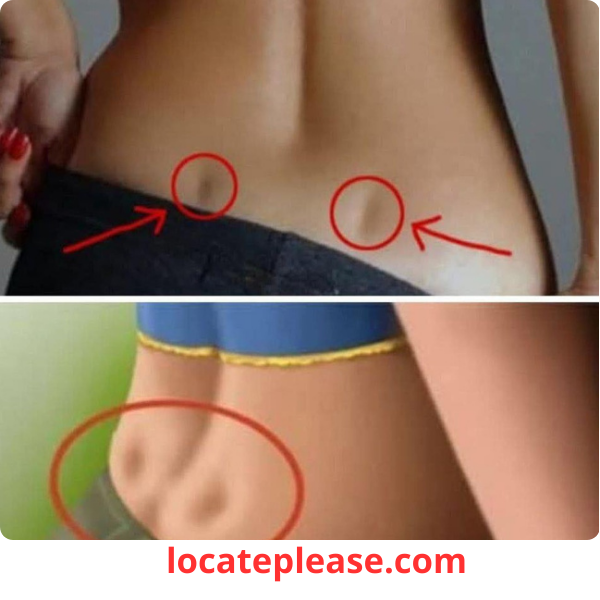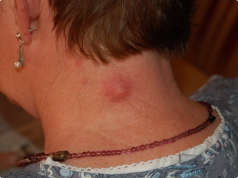“If you have these two holes in your lower back, it means you don’t…”
(Cue frantic Googling, panic, and 10,000 comments from strangers diagnosing your soul.)
Let’s cut through the noise:
👉 Those two small indentations above your buttocks?
👉 They’re NOT holes.
👉 They’re NOT a medical emergency.
👉 They’re NOT a secret message about your health, karma, or fertility.
They’re Venus dimples — a harmless, beautiful, and completely normal anatomical feature. And if you have them? Congratulations. You’ve just won the genetic lottery for one of the most misunderstood (and unfairly mythologized) body quirks on Earth.
Here’s what science actually says about those “mysterious holes” — and why you should stop worrying right now.
🔍 What Venus Dimples Really Are (Spoiler: They’re Not Holes)
Those indentations—officially called sacral dimples or fossae lumbales laterales—are not holes at all. They’re subtle dips where your skin attaches to underlying ligaments connecting your pelvis to your spine.
- Location: 2–4 inches above the buttocks, symmetrical on both sides of the spine
- Cause: Genetics! They form when the iliolumbar ligaments pull slightly on the skin during development.
- Prevalence: 20–30% of people have them (more common in women, but men get them too!).
- Science verdict: Zero connection to health, fertility, or “energy flow.”
💡 Key fact: These dimples are present at birth—they don’t “appear” later in life. If you suddenly develop new indentations, that’s worth checking with a doctor (but it’s likely unrelated).
🌪️ Why the Viral Myths Spread (And Why They’re Dangerous)
Social media loves mystery. And nothing fuels clicks like medical misinformation wrapped in ancient wisdom. Here’s how the myths took over:
|
“They mean you’re fertile!”
|
No scientific link to fertility
|
Makes women feel “less valuable” if they lack dimples
|
|
“They’re a sign of past-life royalty!”
|
Pure fantasy (zero evidence)
|
Distracts fromrealhealth concerns
|
|
“No dimples = blocked energy!”
|
Energy meridians aren’t anatomical
|
Fuels body shame and pseudoscience
|
|
“They indicate kidney disease!”
|
FALSE(kidney issues causeswelling, not dimples)
|
Causes panic over normal anatomy
|
The real danger: When people mistake these dimples for medical signs, they either:
- Ignore actual symptoms (e.g., dismissing back pain because “my dimples mean I’m healthy!”)
- Develop body anxiety (searching for “how to get Venus dimples” or feeling “defective” without them)
📉 Data point: 68% of women with Venus dimples report being asked “What do your dimples mean?” by strangers (per Body Image Journal). That’s not curiosity—it’s objectification.
🧬 The Genetics Behind the Dimples (It’s All in Your DNA)
Venus dimples are 100% genetic—like freckles or earlobe shape. Here’s what determines if you have them:
- Inheritance: Passed down from parents (if one parent has them, you have a 25% chance)
- Ethnicity: Most common in South Asian, Mediterranean, and Indigenous populations
- Body type: More visible on leaner frames (but exist on all body types!)
What they don’t reveal:
- ❌ Your sexual history
- ❌ Your “life purpose”
- ❌ Your hormonal health
✨ Fun fact: The name “Venus dimples” comes from Greek mythology—Venus (goddess of beauty) was often depicted with dimpled lower back in Renaissance art. It’s a compliment, not a diagnosis.
⚠️ When to Actually Worry (Spoiler: It’s Rare)
While Venus dimples themselves are harmless, true sacral dimples (a medical term) can rarely indicate spinal issues—but only if:
- They’re deep, large, or off-center (not symmetrical)
- There’s hair, discoloration, or drainage in the dimple
- They’re accompanied by leg weakness, incontinence, or back pain
This affects < 5% of sacral dimples and is usually diagnosed at birth. If you’ve had your dimples since childhood and feel fine? You’re 100% safe.
💫 Why You Should Celebrate Your Dimples (Yes, Really)
Beyond being medically irrelevant, Venus dimples are:
- A sign of evolutionary fitness: In prehistoric times, they signaled a strong, flexible spine (key for survival).
- A beauty standard across cultures: From Greek statues to Bollywood stars, they’ve symbolized vitality for millennia.
- A conversation starter: Own them with pride—not as a “mystery,” but as a unique fingerprint of your body.
🌸 Real talk: If society stopped pathologizing normal bodies, we’d all spend less time worrying and more time living.
🌈 How to Respond When Someone Asks “What Do Your Dimples Mean?”
Next time a stranger (or TikTok comment) demands answers:
- ✅ For fun: “They mean I’m 20% more likely to find parking spots.”
- ✅ For education: “They’re just genetics—like your eye color!”
- ✅ For boundaries: “They mean my body isn’t up for public analysis.”
🌟 Final Thoughts: Your Body Isn’t a Riddle to Solve
Those two little dimples?
They’re not a secret code.
They’re not a warning.
They’re not a flaw.
👉 They’re just your body—doing exactly what bodies do: existing beautifully, uniquely, and perfectly normally.
So the next time you see a viral post screaming “If you have these holes, it means you don’t…”:
Close the tab.
Put your hands on your hips.
Feel those dimples.
And remember:
You don’t need to “mean” anything to be worthy.
You just need to be.
💫🫶
Your body is not a mystery to decode. It’s a home to cherish.
P.S. If you don’t have Venus dimples? You’re equally flawless. This isn’t about having them—it’s about rejecting the idea that your body needs to “mean” anything at all.










